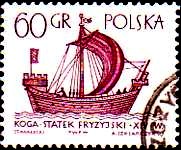
|
Maritime Topics On Stamps :
The Hanseatic League and her ships!
|
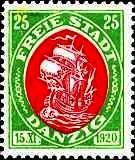
|
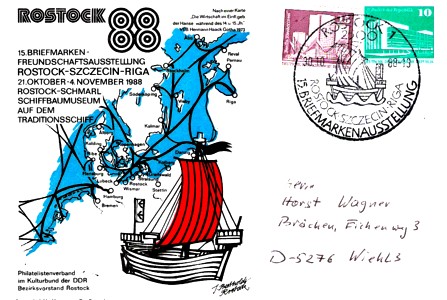
|
Since the 11th century several merchant guilds in Europe combined forces under the name
'Hanseatic League' ('Hanse' meaning crowd, community). The original goal was to maximize
security for the merchants on their journeys. From the 12th century on this agreement evolved
to become a large federation of cities in Northern Germany. At its peak this fedaration
consisted of up to 200 european cities. The Hanseatic League extended from Scandinavia
to Upper Italy and from England to Russia. The Hanseatic League influenced the economic,
political and cultural life in Europe for nearly four centuries.
| |
The major trade routes of the North and Baltic Sea are depicted on this postcard. Norway,
England and France as well as the river waterways und land routes are missing.
|
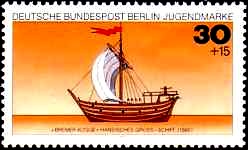
|
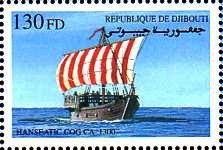
|
The Hanseatic League used the cog as their ship of choice. The cogs were developed
from the 'Knorrs' of the Vikings
. They had a high-boarded, round, clinker planking hull
with a steep stem and straight keel. The length-to-breadth-ratio was three to one.
A solid, continuous deck was installed to protect the cargo. The first cogs
still had an old rudder on the starboard side which later on was replaced by a stern rudder.
The ships had a single mast rigged with a yard sail although additional oars were still
in use for a long time. On the stamp to the left you can see a cog excavated near Bremen
in 1962. She is dated to the year 1380 and according to her data belonged to one of the smaller
cog types: L - 77 ft, B - 23 ft, draft 7 ft, loading ability 42 to 60 loads, i.e.
approx. 120 tons, crew 15 - 20 man.
At that time the loading capacity was measured by 'loads' which differed,
though. There were loads of salt, loads of rye, loads of herring etc. For the cogs a
load was approximate two tons.
|
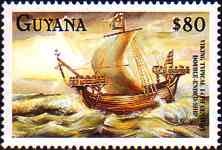
|
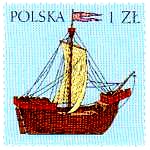
|
With the beginning of the 14th century platforms were built in front and aft of the cogs
to host a score of warriors, the so-called small forts. The top of the mast was also used
as a battle station. The mast height reached approx. the quadruple of the ship breadth,
about 39 to 79 ft, with 540 to 1,530 sqft of sail area. Pushed by a strong breeeze the
ships could run 5 to 6, up to a maximum of 8 knots.
On the stamp to the left a ship is shown originating from a seal of Dover from the year 1305.
One can recognize the rudder on the port side, but it was probably on starboard
side. The sail area was approx. 1,100 sqft. On the stamp to the right you can see a
reconstructed cog found in 1975 at Danzig. The cog on the Polish stamp at the
top of this page looks similar, which was built according to a seal from Stralsund
from 1329.
In the following years the ship size increased. In 1227 the average
capacity of the cogs reached 20 loads, in 1300 it had already doubled to 40 loads.
In 1358 60 loads were reported and in 1400 the average capacity consisted of 100 loads
(approx. 200 tons).
|
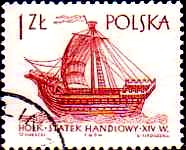
|
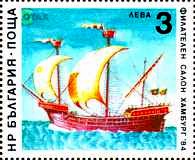
| |
On the stamp to the left you can see a single-masted Hulk (Holk) taken from a seal of the
city of Danzig around 1400. From this Dutch type and the previous cogs a three masted ship
type was developed, which was at one time called Hulk as well, and at other times 'new
version of the cog'. In the middle of the 15th century these ships got smooth carvel
planking, which made them running a lot faster. The top of the mast was replaced with
a so-called 'Mars' - a small fort-like platform for additional warriors and weapons.
Foremast and main mast were rigged to carry yard sails and the mizzen mast got a lateen
sail for a better performance when sailing close-hauled to the wind. These ships had the
following data: l - 98 ft, b - 26 ft, d - 10 ft, load-capacity 100 loads translating
to 200t, sail area 2700 sqft.
|
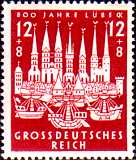
|
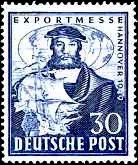
| |
The strongest influences for the development of the Hanseatic League in the North Sea
and Baltic Sea arose from the city of Lübeck, depicted on the stamp to the left. From
here trade routes ran to Visby/Gotland, to Nowgorod, Bergen, Brügge, London and several
important inland areas. Center of the Hanseatic holdings in each city was the so-called
'Hansekontor' - offices so important that they got to carry their own names like the
'Petershof' in Nowgorod, the 'Deutsche Brücke' in Bergen and the 'Stalhof' in London.
On the stamp to the right the merchant Hermann Hillebrandt Wedigh is depicted, (resembling
a painting of Holbein). He represented the Hanseatic League at the London Stalhof. Since
the end of the 13th century nobody challenged Lübecks leadership. This was the place to
hold the Hanseatic League fair, and its leaders created the guidelines for all other offices.
|
|
The Hanseatic League traded the grain surplus from the east, fish from Bergen and
Visby, cloth from Brügge and wax, honey, furs and amber from Nowgorod. On the Norwegian
stamp you can see a cog/Hulk with symbols of dried and salted cod.
At that time there weren't any shipping companies. A ship had several owners and
usually the captain held a share as well. Merchants purchased shares in many ships to
distribute the risk of shipwrecking and piracy.
|
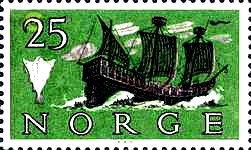
|
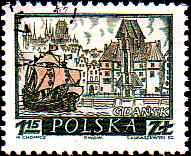
|
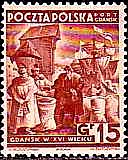
|
In the 15th century over 1,000 ships with a capacity of approximate 45.000 loads
(approx. 90,000 tons) sailed under the flag of the Hanseatic League. The annual
transportation reached more than 200,000 tons. More than 300,000 barrels of
fish were shipped from Schonen every year. 1,100 ships left Danzig carrying grain to the
Netherlands and Belgium. The typical crew of cog consisted of 15 to 20 men and some
merchants and their staff. During war times and in pirate areas a small
contingent of soldiers was carried along, the exact number depending on the ship's size
and value. The Hulks could carry approx. 100 men.
On the stamps you can see ships and merchants in the port of Danzig. The famous Danziger
crane gate can be seen in the background, a loft with an integrated crane which was
already operating at the time of the Hanseatic League.
|
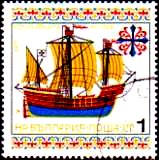
|
Cogs weren't warships. They carried warriors in their small forts for self defense.
Nevertheless some ships were explicitly converted for fighting purposes.
They were called 'peace ships' to 'pacify' the enemy. A variant were the 'outlieers', small
vessels guarding river mouths. There was also the 'Orlogship', which directly translates
to warship. Theses ships were armed with bows, crossbows, slings and catapults. During
the 15th century the development of powder weapons brought 'arkebusen' (a forerunner of the
rifle), little guns called 'snakes' and heavy cannons called 'karonades'.
| |
Later on large cannons, the so-called 'Kartaunen', were added and placed amidships. On the stamp
you can see a ship in 1470 with an elevator for hoisting stones to the top platform. You can also
recognize a white Hanseatic League flag with a black cross here. Every cog had a
flag (a so-called 'Flüger') bearing the colors of her hometown.
|
Despite being a peaceful town federation without political ambitions, the Hanseatic League
never shunned the use of force to achieve its goals. New strategies for war at sea were
developed like convoy voyages, sea blockades and sea landings.
A convoy is a large group of ships travelling at close range for better protection.
Sea blockades and amphibious landings were conducted in the wars of the Hanseatic League
with Denmark and Norway.
In those days a naval battle consisted of three phases. First the attacking ship tries
to reach the favorable windward position to remain maneuverable and block the wind from
the enemy's sails. In the second phase the attacker tries to weaken the enemies using
projectiles, arkebusen and crossbow arrows. In the third phase the attacker boards
the enemy ship and the outcome is decided by close quarter fighting 'man against man'.
|
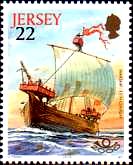
|
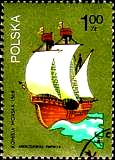
|
In the 13th and 14th century pirates threatened the Hanseatic routes and nearly
brought sea trade to the brink of extinction. The Hanseatic League reacted by
forming convoys which were heavily guarded by the 'peace ships'. To add difficulties
most pirates were sponsored by one or more noble landlords. At that time, violent conflicts
between countries, cities and the Hanseatic League were common. Pirates were hired as mercenaries,
got a privateer letter and sent against the opponent. The pirates could take refuge and
sell their loot in the ports of their sponsor.
|
|
The Hanseatic League also resorted to hiring pirates. Because they delivered 'Viktualien'
(food) to Stockholm the pirates became known as 'Vitalienbrüder' (food-brothers). Later on
they were called 'Likedeeler' (equal shares), as well.
At the end of the 14th century the islands of Gotland and Rügen became main hiding
places for pirates. In 1398 the Hanseatic cities and the Order of Teutonic Knights
assembled an armada of 84 ships and 4000 men. This fleet attacked the pirate-infested
Gotland. The few who managed to escape left the Baltic Sea forever.
|
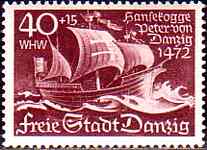
| |
On this stamp the 'Peter of Danzig' is depicted. The ship was built in La Rochelle as
the 'Pierre de La Rochelle' and sold to Danzig in 1462.
In 1470 she was re-equipped for war and commissioned to the English Channel.
After several failures in 1472, she finally managed to capture a ship at the mouth
of the river Themse. (L 141 ft, B 39 ft, 17 guns)
|
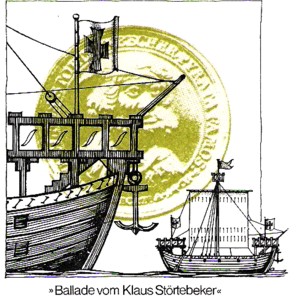
|
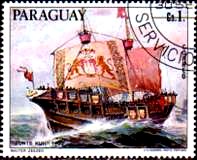
|
The most famous and most legendary pirates were Goedeke Michels and Klaus
Stoertebeker. They started in the Baltic Sea with their battle cry
'God's friend and all the world's enemy' and moved on by dividing the North Sea between
them. Stoertebeker operated in the southeast from the isle of Helgoland - right
in front of the mouths of the rivers Elbe and Weser. Michels haunted the southwestern
regions before England and Belgium. In 1400 a squadron of ships from Hamburg won a large naval battle
against Stoertebeker's fleet. Stoertebeker himself was taken captive and later decapitated in Hamburg.
Several detailled legends exist up to today.
On the cover to the left you can see Stoertebeker on a medallion. On the stamp to the right the
'Colored Cow of Flanders' is depicted. She was commanded by Simon Van Utrecht and was part
of the Hamburg fleet. Allegedly she carried 140 marksmen and fighters.
|
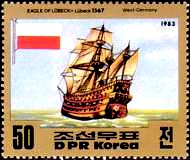
|
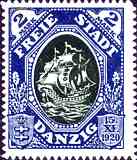
|
In the 16th century the Hanseatic League suffered several defeats against the Swedes
and the Danes. Following these events the Scandinavian countries became more and more
independent from the Hanseatic League. The Dutchmen took over the trade in the Baltic Sea.
England isolated itself and in 1598 closed the famous Stalhof in London. The 30-Year-War
from 1618 to 1648 sealed the fate of all trading companies in Central Europe. In 1669 the
last Hanseatic League Day took place - a mere six towns were attending. The great discoveries
at the end of the 16th and beginning of the 17th century started the ocean-wide trading.
Personal interests of the countries and cities dominated barring the formation of another
city-spanning agreement. The focus of trade shifted from the local seas to the oceans.
On the stamp to the left the 'Eagle of Lübeck' is depicted. In 1565/66 she was built as
a four-mast warship for the Hanseatic League at Lübeck.
However, the ship never had to fight and in 1570 she was refitted to become a merchant ship.
This serves as an example that the Hanseatic League not only used cogs.
|
|
Note: On the Dover seal a rudder can be seen on port side (see the Guyana stamp
above). This may have happened that the engraver hasn't considered that the imprint
is a reverse picture. The rudder surely was on starboard. The English word 'port'
derived from the habit to always moore the ship with the less sensitive port side
at the quay. The background picture shows the Hanseatic League cog built at Kiel.
She is an reconstruction of the cog of 1380, found at Bremen in 1962
|
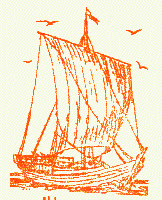
|
|